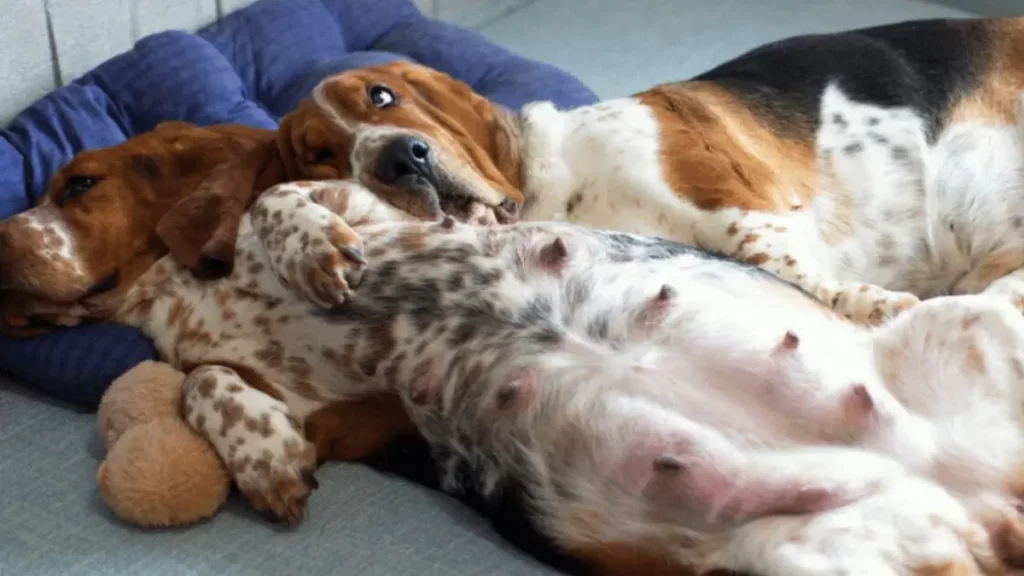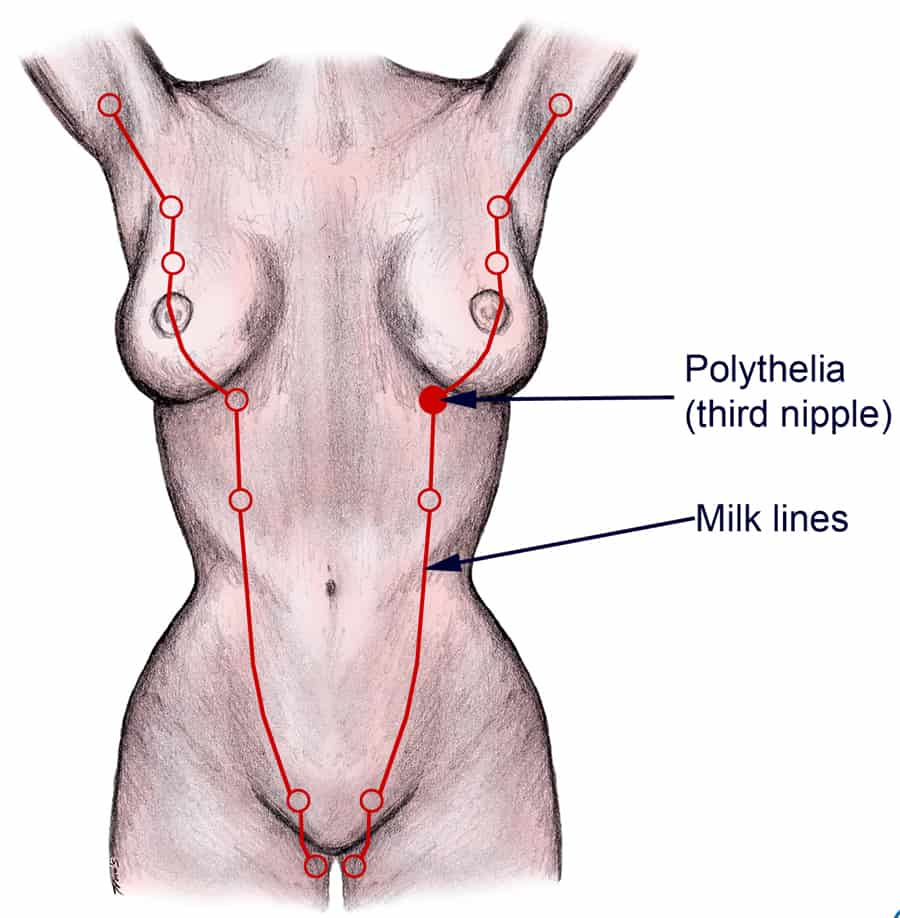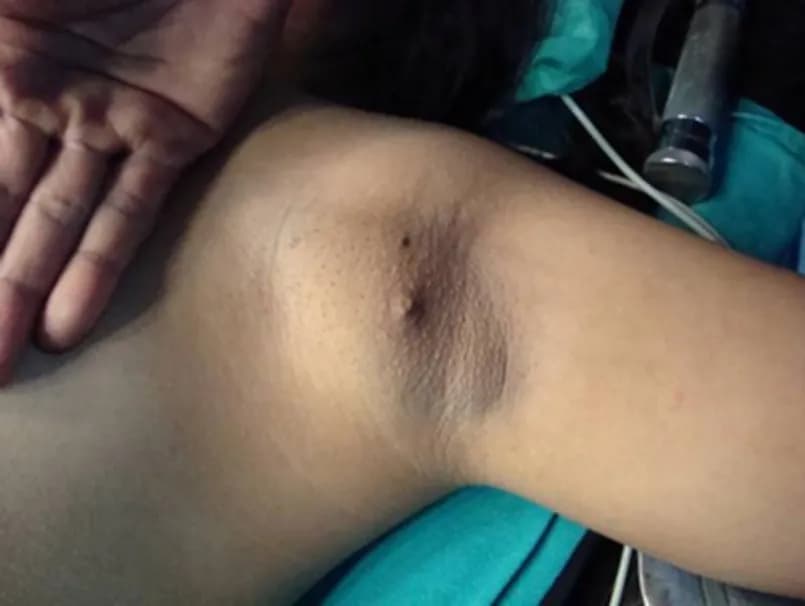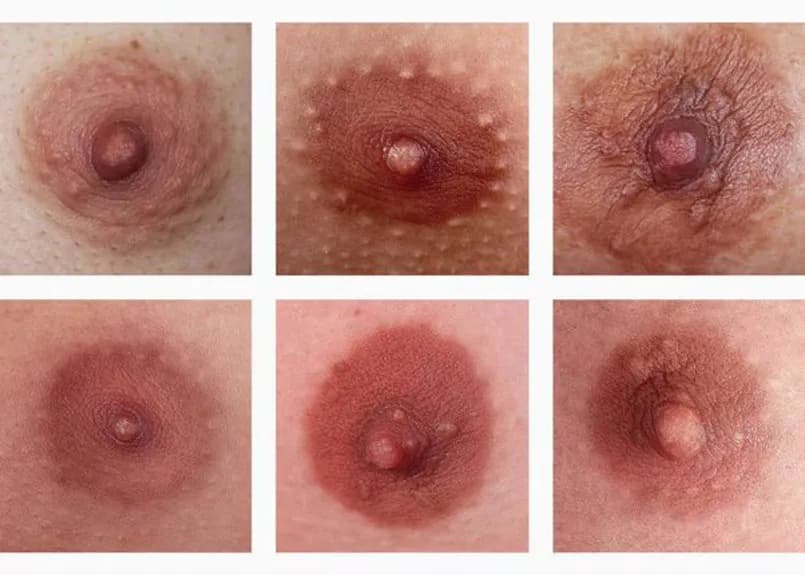Why Do Men Have Nipples?
The nipple is the area of tissue that protrudes from the surface of the breast and allows a female to secrete milk through the milk ducts. “breast” and “nipple” are not the same thing. Using breast and nipple synonymously is anatomically/scientifically incorrect.
Each nipple is a small skin protrusion containing the outlets of 15-20 milk ducts arranged cylindrically around the tip.
Milk can exit the nipple passively, or it can be expelled actively through smooth muscle contractions. Around the nipple is a circular area that is mostly the same color as the nipple but darker than the rest of the body. This area is called the areola.
What Will We Learn?
Nipple Function
The physiological purpose of the nipples is to deliver the milk produced in the female mammary glands during lactation to the baby.
During breastfeeding, the nipple is stimulated by the baby’s lips and sucking behavior, and the nerves here stimulate the hypothalamus to release oxytocin.
Oxytocin is a hormone that increases during pregnancy and acts on the breast tissue to help produce the milk ejection reflex.
The increased oxytocin as a result of the baby’s stimulation of the nipple causes the uterus to contract even after birth.
The strong uterine contractions produced by the stimulation of the mother’s nipples help the uterus compress in its arteries.
These contractions are necessary to prevent the bleeding experienced by postpartum mothers.
When the baby suckles or stimulates the nipple, oxytocin levels rise and the tiny muscles in the breast contract to move milk through the milk ducts.
The result of the baby stimulating the nipple helps to transport the breast milk to the nipple through the ducts.
This process is called the “milk squirt reflex”. For a good grip, the bottom of the areola (the colored area around the nipple) should be in the baby’s mouth and the nipple should be able to be pulled into the baby’s mouth.
A weak grip cannot provide sufficient breast stimulation to generate the milk ejection reflex.
If the baby’s mouth only grasps only a small part of the nipple, the nipple may not be adequately stimulated.
This poor attachment can cause sore and cracked nipples and a mother’s reluctance to continue breastfeeding.
After birth, the mother’s milk production increases due to continuous and increased stimulation of the nipple by the baby.
If the baby’s breastfeeding time increases, the mammary glands respond to this stimulus by increasing milk production.
Nipple Anatomy
Marsupials and placental mammals have nipples in numbers ranging from 2 to 19 pairs, usually evenly distributed on both sides of the body.
Milk Line: Formation Of More Than Two Nipples In Humans
An animal has a tissue pathway called the “milk line” or “milk streak” where the nipples develop.
This tissue is located on the front (chest) side of the body and extends from the arms to the legs.
For example, the milk line in a dog looks like this:

You might think that because humans only have 2 nipples, they don’t have a milk line. But this is not true. Humans descended from ancestral primates with more than two nipples throughout their evolutionary history also have a long milk line:

This mammary line produces the breasts and mammary glands. But in humans, this should only happen in the breast area that is considered “normal”.
However, between 0.4% and 6% of women, accessory (extra) breasts are produced in addition to the two “normal” breasts. Two-thirds of women with this condition do not show any symptoms and simply think they have “gained weight”.
However, 1 in 3 patients may experience problems, especially during menstruation and milk production (lactation) periods.

Academic studies show that 67% of additional breast formations occur in the breast (thoracic) or abdominal (abdominal) side of the milk line. Most of these develop on the left side of the body and in the under-breast region.
20% of the remaining part occurs in the axilla region as shown above. The remaining 13% can occur at any point in the milk line given in the images above.
Many pairs of udders are produced along this line in other creatures (eg cats and dogs). The fact that there are 2 of these in humans is related to the selection pressure in the evolutionary process.
The Number and Positions of Breasts in Non-Human Animals
We can list the number of breasts in some species and their positioning on the body as follows:
- Goats, sheep, horses and guinea pigs have a total of 2 udders, 0 on the chest, 0 on the abdomen and 2 on the groin.
- In cattle, there are 4 breasts in total, 0 in the chest, 0 in the abdomen, and 4 in the groin.
- Cats have 8 breasts, 2 on the chest, 2 on the abdomen, and 4 on the groin.
- Dogs have a total of 8-10 udders, 4 on the chest, 2 on the abdomen, and 2-4 on the groin.
- Mice have a total of 10 udders, 6 on the chest, 0 on the abdomen, and 4 on the groin.
- Rats have a total of 12 udders, 6 on the chest, 2 on the abdomen, and 4 on the groin.
- Pigs have a total of 18 udders, 6 on the chest, 6 on the abdomen, and 6 on the groin.
- Elephants have a total of 2 udders, 2 on the chest, 0 on the abdomen, and 0 on the groin.
In humans, the milk line begins to form at week 7 of pregnancy, and at week 8 to 9, nipples are produced in the “normal” area on the breast. Later, the breast line pauses and trophies.
However, in some people this atrophy may not occur properly and extra nipples may be produced, as in our distant cousins.
Since our earliest mammalian ancestors had a greater number of breasts, this could be considered the emergence of an ancestral character.
As we just mentioned, additional nipples in humans almost always form above the milk line. But in the vast majority of these cases, the additional nipples produced are dysfunctional.
Many people think that these additional nipples are “nevi” and live without realizing it for the rest of their lives.
Male Nipple And Female Nipple
Nearly all mammals have nipples in both males and females. In humans, the nipple can be used to provide sexual arousal in both sexes.
However, in human societies, only the female nipple has been turned into a sexual object.
For example, while nude male breasts are not prohibited on many sites on the internet, nude female breasts are prohibited. There is no such prohibition in this article, which serves a scientific purpose.
However, in order to demonstrate the unfoundedness of this sexual objectification, we invite our readers to guess which of the following nipples are male and which are female:

Why Do Men Have Nipples?
Short Answer
We all start growing as women in the womb. We are born male or female depending on the Y chromosome that is added or not added later. By the time this Y chromosome arrives, the breasts are already formed. Because this chromosome does not react, men’s nipples do not become as large as women’s. That’s why men have nipples.
Long Answer
Although the males of many mammalian species have nipples, in almost no species the males do not contribute to the feeding of the young.
The question of why there are nipples, then, may seem like an evolutionary mystery.
However, the answer to the question is quite simple.
Biologically, the most important of the 45 genes on the Y chromosome that allows the male body to be specialized is a gene called SRY (or Sex Determining Region Y in its clear form).
This gene is found in all marsupial and placental mammals. The protein produced by this gene is called the Testicular Determining Factor, and this protein enables the production of testicles in marsupial mammals such as kangaroos or placental mammals such as humans.
Triggered by the Testicular Determining Factor, the testicles begin to produce sperm and, through the testosterone they secrete, the sperm duct and the penis are formed, and even the tissue of the brain changes.
As a result, the male brain becomes desensitized to progesterone and estrogen, especially estradiol, which are much more active in women, although they are also found in men.
In other words, the activity of a single gene almost recreates the physiology and anatomy of the individual.
The differentiation process that begins with the Y chromosome also answers the interesting evolutionary question about why men have nipples.
The beginning of the differentiation process of male characteristics, which we have described above, takes 6 to 8 weeks after the union of the sperm and egg.
In other words, 1.5-2 months have passed before the gender of the embryo is determined in the mother’s womb.
Meanwhile, the embryo goes through a tremendous process of mitosis and constantly creates new cells, and these cells trigger the differentiation of other cells with the signals they release around them.
Thus, different parts of the chromosomes are read and different structures begin to be produced.
In the first 8 weeks of embryological development, the embryo has Müller and Wolf ducts, which are the precursors of both female and male reproductive systems.
Immediately after fertilization, if the Y chromosome is present, the X chromosome is inactivated.
If the individual does not have a Y chromosome, the Müller duct develops, in this case the embryo develops as a female. In the 8th week, protein synthesis starts from the SRY gene on the Y chromosome and TDF protein is formed. During this period, Leydig cells form and begin to produce testosterone.
Testosterone suppresses the Müller duct and promotes the development of the Wolf’s duct.
Wolf duct develops to form male genitalia.
The thorough development of testicles increases the secretion of testosterone and accelerates this embryo to gain male character.
The testosterone hormone will play a very important role in future muscle development, hair growth, areas where body fat will accumulate, and character traits.
On the other hand, the formation of mammary tissue in mammals occurs only around the 10th day and takes shape between 4-6 weeks.
That is, much earlier than the determination of male characteristics at 6 to 8 weeks!
At that point, it is unclear whether the gender will be male or female.
Therefore, breast tissue and nipples are formed in both males and females.
In fact, in males of other mammals, this tissue may disappear during development.
For example, in mouse embryos, five major mammary tissue buds form very early in pregnancy in both male and female embryos, but in male mice this tissue begins to degenerate within a few days.
So much so that in male mouse embryos, the mammary buds completely disappear, not even a nipple remains.
In males of other mammals such as humans, a small portion of the bud remains, and this is what forms the nipple in adult males.
In female mouse embryos, mammary buds survive and mammary development continues to form both the nipples and internal structures that will develop into functional milk-producing tissue in adult female mice.
It seems that a protein called PTHrP both reinforces nipple formation in females and causes nipple atrophy in males.
Difference Between Male And Female Nipple
Nipples in newborn babies have a very similar appearance, regardless of gender.
However, this appearance begins to change under the influence of hormones that begin to be secreted with the onset of puberty. In both sexes, breast tissue begins to grow with puberty.
But in women it grows much more than in men.
On the other hand, with puberty, the milk ducts of males narrow and become smaller. The females, on the other hand, enlarge and change structurally.
In adolescent boys, the nipple is also excitable. It even hurts when it hits or squeezes something. In 50% of adult men, the nipple is also erogenous (sexually aroused) as in women.
Breast tissue in men can cause problems, especially in those with hormonal disorders.
Similarly, athletes who use steroids for a long time have testicular dystrophy.
Because there is more testosterone in the blood, the testis does not produce secretion and becomes smaller.
When the testosterone serum level is high, some of it is converted to estrone via the aromatase enzyme. Estrone is one of the estrogen hormones.
This hormone causes breast enlargement by affecting the breast tissue.
The functional potential of the male udder often does not translate into a practical function, because evolutionarily and genetically, males have not been selected to produce milk.
One of the reasons is that during puberty, oxytocin and prolactin levels increase in women, while men do not. Therefore, men do not go through the changes that the female breast tissue undergoes during puberty.
For example, women have around 30% more prolactin in their blood than men. In pregnancy, this rate increases 10 times.
Accordingly, at puberty, the mammary ducts of women tend to branch off, while those of men generally shrink.
However, these nipples do not completely lose their function and can expand again when stimulated.
One review found that men’s nipples are around 36% smaller than women’s, and there is greater variation in nipple area and size in women.
What Are The Similarities In The Reproductive Systems Of Males And Females?
Although we talked about the sexual differences of these two sexes above, the reproductive systems of males and females are actually quite similar.
This shows us how much the Evolutionary Biology explanations we made above reflect the truth.
First, the most basic similarity of the reproductive systems of the two sexes is that they both consist of differentiation of exactly the same tissue.
Therefore, the initial states of the cells that make up the reproductive systems of both sexes are the same.
They differ in different directions only under the influence of different chemicals.
Tissues in this way are called histologically (cellular and textural) homologous (synonymous) structures.
The secondary similarity between the systems is that both sexes have specialized structures, which we call gonads, that produce reproductive cells.
Finally, another most typical similarity is that neither system is fully activated until puberty.
Therefore, from a developmental point of view, the development of the reproductive system continues rapidly after birth and more than 10 years must pass before it reaches the active phase.
One last piece of information we can give on this subject is a myth developed by people who are generally ignorant of the subject: “The clitoris on the vagina is actually an underdeveloped penis.” This is a completely wrong explanation.
The clitoris and penis are histologically homologous. However, it is not correct to make any analogies between the penis and the clitoris.
Although a bulging clitoris can be visually compared to a penis.
It is even mentioned in ancient stories that women with the excessively swollen clitoris in this way were suspected of being men.
This is not the case, the bulging clitoris is just a variation and doesn’t make any sense.
Can Male Breasts Produce Milk?
Functionally, a man’s breast tissue and nipples are also no different from women’s and can produce milk. In fact, in one study, men’s milk and women’s milk were examined.
It has been observed that male milk is in the same nutritional range as colostrum produced by a woman who has just given birth and seen as the most vital mammalian milk.
Lactation is the name given to the females of mammalian animal species such as humans to pour the mammalian milk secreted from the mammary glands out of the body in order to feed their young. By definition, lactation is defined for females only.
On the other hand, contrary to popular belief, it is known that in some mammalian species, including man, the nipples of males can also produce milk in a form that is nutritious for the young.
This uncontrolled leakage of milk, which can sometimes be called male lactation, is called male galactorrhea in medicine (5-32% of women experience galactorrhea).
For example, males of Dyacopterus spadiceous, Pteropus capistratus, domestic goats and guinea pigs (Cavia porcellus) can also produce milk and feed their young, just like their females.
For example, Thorazine, produced as an antipsychotic drug in the mid-20th century, affected the pituitary gland, causing excessive prolactin production and indeed triggered milk production in men.
Similarly, tumors that press on the pituitary can also cause this. In addition, breast-fed newborn babies may also get plenty of prolactin from breast milk, so their nipples may swell and turn white as if they are going to produce milk.
Some experts claim that even just stimulating the nipple, as in women, can cause a surge of prolactin and ultimately milk production in men.
But this is a somewhat more controversial issue and has not been consistently confirmed empirically.
Our article on the midlife crisis may also catch your attention.
